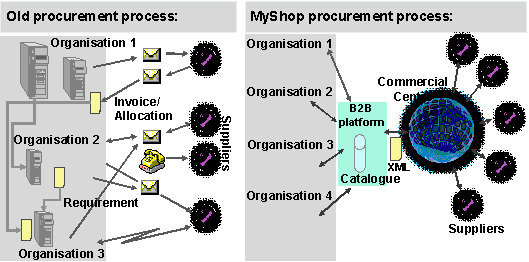Electronic procurement of MRO materials and services at UBS AG
In order to efficiently process its procurement in Switzerland, UBS AG developed and implemented the MyShop procurement solution in collaboration with Conextrade and SAP. This has simplified and accelerated procurement processing for MRO materials and selected services and produced economies. MyShop began operating in June 2002 and will be used on an ever-broader basis in the coming years. It is among the leading E-Procurement solutions used by European banks.
1. The company
UBS is a leading financial institution that provides financial services for demanding customers all over the world. It has the claim of combining financial strength and innovative ability in an international business structure and sees changes as opportunities. UBS is a world leader in private banking and one of the largest investment managers. In investment banking and securities trading it occupies a leading position among the top global financial institutions. In Switzerland it is far and away the number one in the private and corporate business. As an integrated corporation, UBS draws on combined resources and the expertise of all business units. The UBS vision is to be an outstanding global integrated financial services company and Switzerland’s leading bank.
Banks face keen national and international competition. Besides competitive products, efficient processes are decisive to success. These processes are supported to a large extent by IT solutions that are often custom-developed with partners. Banks came to grips with E-Business early on; first on the sell side (E-Banking) and increasingly on the buy side.
2. E-Business vision and E-Business strategy
Importance of E-Business in the corporate strategy
E-Business is a means for UBS to satisfy customer needs and optimise its own business activities and processes. The present case study concentrates on the procurement of MRO materials and selected services in Switzerland.
Procurement at UBS
In Switzerland USB buys investment goods, materials and services (incl. external employees) to a value of approx. CHF 4 billion annually. Many product ranges are bought locally thus bypassing Central Purchasing: central IT, marketing services, logistics, external employees, catering/canteens etc. Only a small share of orders are made via the Purchasing Department. Even where relevant instructions exist, they are not always complied with. The result is less-than-ideal procurement processes and a lack of information, for example, on financial commitments resulting from placed orders (liabilities). UBS Switzerland has 25,000 creditors, of which the Purchasing Department services 3,200 suppliers with a procurement volume of approx. CHF 400 million. Fig. 2.1 shows the procurement situation at UBS Switzerland:

Fig. 2.1: Distribution of creditor sales by UBS Switzerland in 2001 (%)
Notes:
- Procurement using SAP/R3: conventional procurement of goods and services via the Purchasing Dept. (41,000 invoices)
- Procurement using E-Procurement: fully-automated process for office consumables (238,000 records)
- Other purchases: local purchasing not initiated by the Purchasing Dept. (251,000 invoices)
- Other creditor invoices: public authorities (114,000 invoices)
- The most important problems were:
- No overall view of the separate procurement processes
- High procurement costs and long lead times resulting from manual interfaces, gaps in media and data redundancy
- Computer-aided procurement functions were developed to complement the existing systems
- The processes associated with ordering are handled by different systems (e.g. budget control, order liability management etc.)
- Time- and work-intensive preparation of management information
In 1998, it was decided to explore ways of rationalising procurement. The upshot, in February 1998, was that office supplies (office consumables only) were transferred to outsourcing partners. This affected several thousand invoices a year with approx. 200 suppliers. At the beginning of 1999, the focus was shifted to four partners: Büro-Fürrer, Waser Büro; logistics by Serlog and Antalis (incl. paper deliveries and storage of UBS material). GATE, a fully-automated solution, is based on SAP’s MM and SD modules and uses EDI interfaces. Access to a catalogue comprising 1,500 articles was provided to 4,000 employees with responsibility for ordering materials for 35,000 workplaces. Articles can be located and placed in the shopping basket. Up to 1,000 orders per day are now passed directly to the regionally distributed suppliers. The delivery plan comprises approx. 600 buildings in Switzerland, supplied on a daily to weekly basis (approx. 60 tons of office materials per week; approx. 330 million pages of copy paper annually). The departments have limited storage space at their disposal. The monthly invoice is transmitted electronically and settled automatically. The solution has reduced the volume of records by about 50%; some 65 jobs have been cut in stages. The procurement volume of some CHF 20 million annually processed in this way corresponds to about 0.5% of the entire total.
In 2000, attention was turned to the question of how the rationalisation of procurement could be moved forward. UBS participated in a benchmark testing of its MRO procurement conducted by the TECTEM Institute at the University of Sankt Gallen. The result led to UBS’s MyShop vision: “From complexity to simplicity.”
The aims of MyShop were:
- To increase efficiency in procurement: automation of the order, approval and settlement processes; implementation of best-practice procurement processes without media gaps; implementation of a state-of-the-art E-Procurement solution based on standard software linked to a commercial centre
- To completely integrate it into the SAP R/3 back-end system: end-to-end order liabilities management, increased cost transparency, improved cash management
In the medium term, some 400 suppliers with more than 200 invoices or more than CHF 1 million in turnover annually will be linked to the solution.
UBS aims to be the leading bank in terms of successful E-Procurement in Switzerland and Europe and thus simplify its procurement processes and process them faster and cheaper.
A commercial centre was sought as a procurement partner. UBS encourages its main suppliers to participate in the commercial centre; for their part, suppliers can use it to acquire new customers. The commercial centre should simplify interfaces and take on significant parts of content management for the product catalogue.
Table 2.3: Milestones in E-Procurement
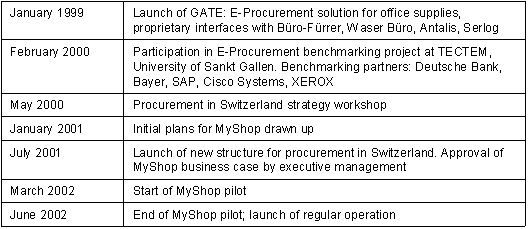
Partners
Procurement partners
The commercial centre was evaluated by the UBS IT business unit based on requirements defined by the Purchasing Department. ARIBA and SAP/Conextrade were shortlisted. The prime reasons for choosing SAP/Conextrade were:
- Full integration into the existing SAP R/3 ERP system
- Fully automated electronic settlement
- Outsourcing of catalogue content management
Conextrade proved to be the only horizontal commercial centre in Switzerland. Comparison with foreign suppliers showed that Conextrade is competitive. Conextrade, a wholly-owned subsidiary of Swisscom, offers solutions that enable and safeguard inter-company electronic trading; since June 2000 it has operated Switzerland’s leading commercial centre. It integrates cross-company business processes in procurement into the processes and systems of the relevant trading partners. Buyers and sellers benefit from end-to-end electronic process support that enables data and documents of various provenance to be exchanged.
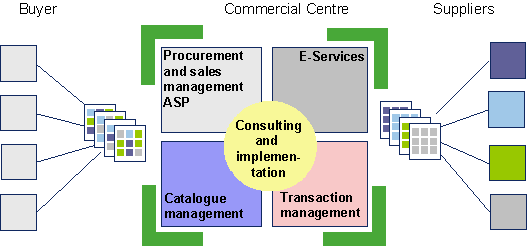
Fig. 2.4: Conextrade’s modular service portfolio
Conextrade’s solutions are modular in design (Fig. 2.4) and comprise:
- Consulting and implementation: introduction and operation of an electronic purchasing or marketing solution
- Purchasing and marketing management: electronic depiction of the sales or marketing process, from an efficient ASP (application service providing) solution to integration and complete EDI solutions.
- Catalogue management: Preparation, transmission and updating of product data; access to multi-supplier catalogue in Conextrade
- Transaction management: Switching and conversion of various data formats and translation of various documents. The participants communicate independently of technologies and protocols in place
- E-Services: Value-adding services for the procurement process such as support for online buy and sell auctions
The basic Conextrade modules described here are based on modern technology components that were combined to best effect in an all-embracing architecture. They include interfaces to leading ERP systems and procurement applications (SAP, Commerce One, Compudata, Ariba, I2, Oracle and others). Enterprise application integration (EAI) is supported by systems with webMethods, among others. Requisite Technologies’ tools are used to edit and publish catalogue data. Conextrade is hosted by Swisscom IT-Services AG; Swisscom Enterprise Solutions AG offers telecommunication services.
ERP supplier/Existing IT partner
USB defined the existing SAP R/3 as the IT platform. SAP’s first standard product to enable browser-based ordering was launched at the end of 1990s under the name BBP. SAP subsequently developed its EBP (Enterprise Buyer Professional) product together with Commerce One.
3. Procurement solution
The MyShop E-Procurement solution at UBS is browser-based and lets authorised employees order defined materials and services. These are presented in a standardised catalogue and can be moved to a shopping basket directly or using an intelligent search function. In exceptional cases, Conextrade catalogues outside the UBS range and suppliers’ e-shops can be accessed (using “round trip” via an OCI interface). If a request requires approval, the authorisation process is initiated. The actual processes depend on the rules stored for each person, for example, procurement power, authority to approve etc. Once approval has been sought, a product line order is updated in SAP R/3 and simultaneously transmitted to the supplier in XML format via the commercial centre. The order is automatically allocated to an account and validated against the SAP R/3 back-end system online. Furthermore, the components provide functions to confirm receipt of the goods and to trace open orders and approval processes.
The product data is structured according to UN/SPSC (United Nations global standard) and RUS (Requisite Unifying Structure) standards. The product groups are then allocated to internal UBS account groups to enable invoicing according to the UBS register of accounts. The suppliers send single and collective invoices that are automatically checked and posted (with exception messages in case of discrepancies).
Supplier evaluation is made by the Purchasing Department in cooperation with the technical offices at UBS. Finally, negotiations with new suppliers take place, leading to framework agreements. UBS defines the products that apply to them and the information they require. The supplier processes the product data in conjunction with Conextrade. UBS then receives the product data applicable to the catalogue in its system.
The solution presented is a buy-side solution. By having its catalogue maintained by a commercial-centre provider, UBS seeks to create additional incentives for its suppliers to participate in the electronic trading. The outlay involved in preparing electronic data does not have to put up for UBS alone as the marketplace enables other customers to be connected to the same range of stock.
Fig. 3.1 shows which functions are provided by whom. The functions fulfilled on the procurement side are listed on the left in which UBS is indicated by dark fields and Conextrade by light ones. The suppliers listed on the right-hand side provide content management for the article data and interfaces for data interchange. In turn, they also avail themselves – at their own cost – of some Conextrade services.
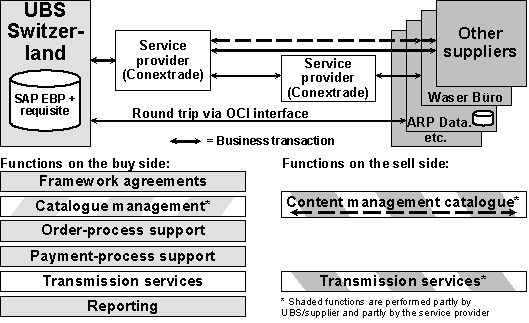
Fig. 3.1: Distribution of basic functions at UBS MyShop
4. Implementation
A cooperative line of action in conception and implementation was maintained between UBS and Conextrade. There were two teams at UBS – one for IT, another for business processes.
The solution development is outlined in Table 5.2. Following the launch of the pilot in March 2002, 20 suppliers with 20,000 invoices were connected by July 2002. The long-term goal is at least 60,000 invoices per year. Every year, 30 to 50 new suppliers should be connected.
Many suppliers will remain unlinked to the E-Procurement solution in the future (the postal service, mainframe procurement, a host of smaller suppliers etc.). Although around 50% of procurement volume is handled through some 100 suppliers, not all of them are suitable for the commercial centre. Besides optimisation in process costs, the medium-term aim is to utilise the potential of requirements bundling to reduce purchase prices.
Solution architecture [system architecture]
Inter-company process and system integration at UBS via the Conextrade electronic commercial centre is based on the solution elements of buyer connection, transaction management, supplier connection and catalogue management (cf. Fig. 2.4). Presentation of the solution architecture is based on these modules (Fig. 4.1).
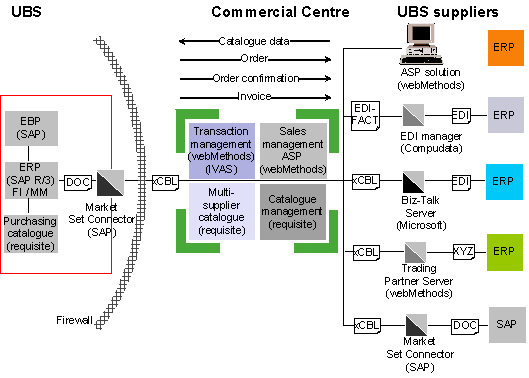
Fig. 4.1: MyShop software architecture
Â
- Buyer connection: the Market Set Connector (SAP) connects the ERP system at UBS with the Conextrade commercial centre. Its counterpart at the commercial centre is the Integration Server, developed by Conextrade based on webMethods.
- Transaction management: The commercial centre supports the exchange of business documents that comply with the xCBL standard and are packed in a MIME (Multipurpose Internet Mail Extensions) envelope. UBS sends orders to Conextrade which the latter forwards to the corresponding supplier based on the address. This means that UBS only has to maintain one technical connection and support just one document format. Correct routing is ensured by the unique trading partner ID (TPID) assigned and allocated by Conextrade. Transaction management checks further whether the document exchange to be effected corresponds to agreements between the trading partners. It is only released if this is the case. UBS’s suppliers send order confirmations by return to UBS. These are converted and passed on by Conextrade in the format required by UBS. In addition, the suppliers send electronic invoices to UBS. These are also converted and sent on in the required format.
- Supplier connection: depending on the available system environment and transaction volume, an interface connects the suppliers to the commercial centre. The solutions deployed range from an ASP (application service providing) solution, for use with a simple browser, to various integration models. The solutions on the suppliers’ side were realised using webMethods, Compudata, Microsoft and SAP technologies.
- Catalogue management: Conextrade compiles the supplier catalogues and presents them in a purchasing catalogue specific to UBS in the intranet. Conextrade ensures the catalogues are updated by means of a standard catalogue-updating process. Multi-supplier catalogue: In addition to the internal purchasing catalogue, UBS uses the multi-supplier catalogue at the Conextrade commercial centre in isolated cases to procure articles not contained in UBS’s own catalogue.
The xCBL and UN/Edifact formats are used for data interchange. The internet is used to connect with the commercial centre via the secure SSL transfer protocol. Its transport encryption guarantees confidentiality and integrity. Certificates are used on both sides for the purposes of encryption and authentication on the transaction platform. At the network, operating system and application levels, various logs are recorded and periodically analysed.
5. Operation
UBS operates SAP with Enterprise Buyer Professional and the purchasing catalogue with data supplied by Conextrade. It also maintains the interface to Conextrade. Precise processes are defined for updating data, product ranges and suppliers, which are periodically checked and adjusted.
Benefits, costs and profitability
On top of the savings made to date by optimisations in Purchasing (as a result of the first GATE project, among others), MyShop will lead to further economies. In 2004, they will contribute some CHF 11 million. Approx. 60% will be achieved by further cutting purchase prices and approx. 40% from savings in staff costs (15% in Central Purchasing, 25% elsewhere in UBS). At the end of 2002, some 70 people will be employed in the Purchasing Department (as opposed to the 190 or so at the beginning of 1998). The cutbacks are a product of early retirement, fluctuations and internal transfers; no redundancies were necessary.
Approx. CHF 11.5 million was invested in MyShop (internal and external expenditure). UBS estimates the payback on MyShop at around two years, in line with objectives.
6. Success factors
The implemented solution is an integrated buy-side solution featuring a multi-supplier catalogue and linked to a commercial centre. It is a leading solution covering processes along the entire transaction chain, including settlement and, for specific product categories, logistics and warehousing as well.
Conextrade satisfied the complex requirements of its reference customer UBS. A platform was chosen that ensures UBS is well-equipped for future development stages, too. A mutual foundation of trust was created through the unstinting willingness to make the project a joint success.
Besides the obvious benefit for UBS, the main difficulty lay in the novelty of the organisation and IT required for MyShop. There was a constant need to find new solutions. Since day-to-day work could, in principle, be carried out without MyShop, users also had to be motivated to use the system.
The chief success factors were:
- The motivation for the initial suppliers arising from UBS’s purchasing power
- The effective project organisation
- The innovation-friendliness and readiness to take on change management by the people involved in the project, including at the grass roots
- Adequate management attention at UBS and Conextrade as well as the commitment of UBS divisional manager Mr. Marbé as the “driving force”.
- The principal difficulties were:
- The software was more complex than anticipated
- Teambuilding at UBS, Conextrade and SAP took time before a feeling of partnership took root
- Handling the contentious issue “Future vision – what can we do/finance effectively”
- Financial matters: despite corrections by UBS, the initial Conextrade offer was too low, causing financial logjams. An important question in this context was: what is generic (for financing by Conextrade) and what is customer-specific (funded by UBS). This question arose, for example, when integrating service providers whose article data did not fulfil requirements.
Conclusion:
- The sticking point in this E-Procurement solution was not convincing management to approve the investment but winning over employees to use the solution. While some success has been achieved in this area, a great deal remains to be done. Suppliers and internal units at UBS have only partially recognised the potential and necessity of MyShop.
- The technology runs smoothly enough.
- A strong “driver” with enough time for a project of this nature is required.

